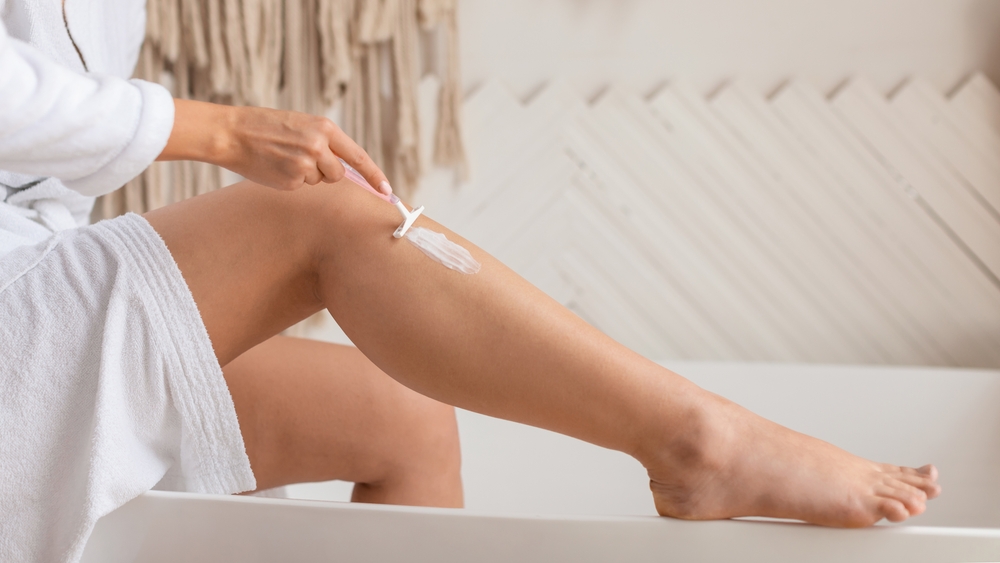As the summer sun beckons us to enjoy its warm embrace, many of us eagerly anticipate poolside parties, beach outings, and outdoor adventures. However, the increase in heat and humidity can sometimes lead to unwanted skin issues, including a common condition known as folliculitis. If you’ve ever experienced those tiny red bumps on your skin, especially after shaving or sweating, you might be dealing with folliculitis.
Folliculitis is a common skin condition related to the hair follicle (hence the name). When the follicle (a small hole or cavity that surrounds the roots of each hair) becomes infected with bacteria, the skin can get red and/or be itchy, and small bumps can appear. Those bumps could look like a rash, or they can become filled with fluid, or be inflamed and painful.
It’s such a common condition because so many different situations contribute to it: daily activities like shaving, hot tubs, sweating, or not drying off enough from the pool or beach.
“Folliculitis tends to worsen in the summer months because heat and humidity create the perfect environment for bacteria to thrive. Additionally, increased sweating and friction from tight clothing or swimsuits can exacerbate the condition,” said Marwa Hakimi, MD of Golden State Dermatology in Brentwood. “Many people tend to ignore it, but like any skin abnormality, don’t assume it will automatically resolve on its own. Avoid self-diagnosing or self-medicating, as any skin rash or eruption could be a sign of something else.”
Different Types of Folliculitis
- Hot tub rash (pseudomonas folliculitis). Its medical name comes from the type of bacteria that causes it, but it’s more commonly known by the activity that leads to it — hot tubs. In fairness you can also pick this up on water slides and in heated pools where the chlorine and pH levels aren’t right. Within a few days after exposure, you’ll see round, itchy bumps that look like a rash.
- Razor bumps (pseudofolliculitis barbae). Despite the name, this is caused by hairs that grow back in on themselves (ingrown hairs), not infected follicles. While it typically affects men with curly hair who shave their faces on a routine basis, in summer months or in hot climates it can affect people who get bikini waxes.
- Malassezia folliculitis. This doesn’t have a more common name, but the cause is incredibly common in hotter climates or warm months: sweating. While sweating doesn’t cause this type of infection (Malassezia are a family of yeast that already exist on the skin), sweating makes it worse.
- Pityrosporum folliculitis. Also related to a yeast of the same name, this type of folliculitis can spread once it gets into the hair follicles. It, too, is typically benign on the skin, and only causes a problem when there’s too much of it.
Don’t Blame It on Summer
While summer does tend to increase the risk of folliculitis, it’s also linked to:
- Prolonged use of oral antibiotics
- Being overweight or obese
- Diabetes
- Stress
- Underlying skin condition (eczema, acne, etc.)
- Pressure (prolonged sitting)
The summer or hot weather conditions that increase the chances you’ll develop some type of folliculitis are:
- Wearing tight, moisture-trapping clothes (like swimsuits)
- Use of oily or greasy products, such as certain sunscreens (but don’t skip the sunscreen; just find a different one)
- Sweating and not fully cleaning your skin or hair
- Being in water that doesn’t have the right pH level
- Frequent shaving
Preventing and Treating Folliculitis

Preventing folliculitis involves good hygiene and skincare practices. Here are some tips to keep those pesky bumps at bay:
- Keep Your Skin Clean and Dry: Wash your skin regularly with a gentle cleanser and avoid leaving sweat-soaked clothing on for too long. Wash athletic clothing after every use.
- Exfoliate Regularly: This helps remove dead skin cells that can clog hair follicles.
- Wear Loose Clothing, especially during exercise: Tight clothes can trap sweat and cause friction, irritating the hair follicles.
- Avoid Sharing Personal Items: Towels, razors, and clothing can spread bacteria and fungi.
- Shaving smart: Shave in the direction of hair growth, avoid shaving irritated skin, and use an electric razor or a new disposable razor every time you shave.
For those already dealing with folliculitis, treatment options vary depending on the severity of the condition.
Treating Folliculitis
While it can be painful, irritating, or just look unpleasant, the good news is that folliculitis usually goes away without treatment. Mild cases of folliculitis may resolve on their own with proper hygiene and over-the-counter treatments. But if you also have a fever, a rash that spreads, or raised bumps that have an odor or are filled with a liquid, consult with a dermatologist. Dr. Hakimi states, “Persistent or severe folliculitis can lead to more serious infections or scarring if left untreated. A dermatologist can provide the necessary interventions to manage the condition effectively and prevent complications.”
If the diagnosis is acute folliculitis, your dermatologist may suggest over-the-counter medications or treatments. For example, with Malassezia folliculitis, one treatment is using anti-dandruff shampoo. In other cases, depending on the duration or severity, the doctor may prescribe oral or topical antibiotics or antifungal medications to treat the cause of your infection, or non-steroidal anti-inflammatory drugs (NSAIDs, like aspirin) or antihistamines to relieve pain or itching.
“As with any other kind of skin condition, the key is to know what’s normal for you,” said Dr. Hakimi. “When you see something developing on your skin that isn’t usually there — like raised, red bumps — that’s something to pay attention to.”
Embrace a Folliculitis-Free Summer
Summer should be a time of fun and relaxation, not of worrying about skin problems. By understanding folliculitis and taking proactive steps to prevent and treat it, you can enjoy the season with confidence. Remember, the team at Center for Dermatology is here to help you achieve and maintain healthy, beautiful skin all year round.
Don’t let folliculitis put a damper on your summer plans. With the right care and guidance, you can keep your skin smooth and free of irritation.
If you’re experiencing any skin concerns or need expert advice, schedule an appointment at Center for Dermatology in Sacramento today!





